
French postcard by Editions Cinémagazine, no. 217. Photo: United Artists.
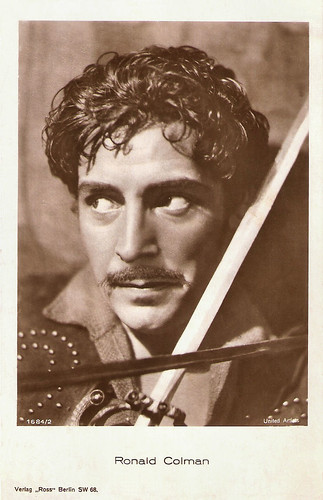
German postcard by Ross Verlag, no. 1684/2, 1927-1928. Photo: United Artists. Publicity still for Two Lovers (Fred Niblo, 1928).
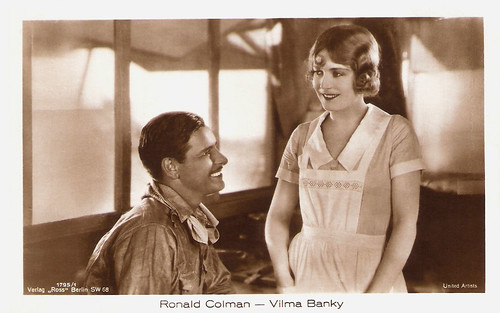
German postcard by Ross Verlag, no. 1795/1, 1927-1928. Photo: United Artists. Publicity still for The Winning of Barbara Worth (Henry King, 1926) with Vilma Bánky.

German postcard by Ross Verlag, no. 3943/1, 1928-1929. Photo: United Artists.
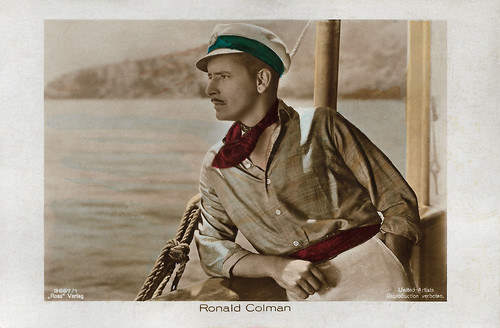
German postcard by Ross Verlag, no. 3667/1, 1928-1929. Photo: United Artists. Publicity still for The Rescue (Herbert Brenon, 1929).
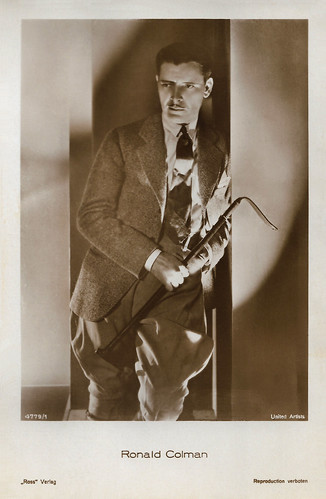
German postcard by Ross Verlag, no. 4779/1, 1929-1930. Photo: United Artists.

Italian postcard by Vecchioni & Guadagno, Roma. Photo: Columbia EIA. Ronald Colman in Lost Horizon (Frank Capra, 1937).
Decorated, discharged and depressed
Ronald Charles Colman was born in 1891 in Richmond, England. He was the fifth of six children of silk importer Charles Colman and his wife Marjory Read Fraser. Ronald was educated at a boarding school in Littlehampton, where he discovered he enjoyed acting. When Ronald was 16 his father died of pneumonia, putting an end to the boy's plans to attend Cambridge and become an engineer. He went to work as a shipping clerk at the British Steamship Company.
He also became a well-known amateur actor and was a member of the West Middlesex Dramatic Society (1908-1909). In 1909, he joined the London Scottish Regiment, a territorial army force, and he was sent to France at the outbreak of World War I. Colman took part in the First Battle of Ypres and was severely wounded at the battle at Messines in Belgium. The shrapnel wounds he took to his legs invalided him out of active service.
In May 1915, decorated, discharged and depressed, he returned home with a limp that he would attempt to hide throughout the rest of his acting career. He tried to enter the consular service, but a chance encounter got him a small role in the London play The Maharanee of Arakan (1916). He dropped other plans and concentrated on the theatre.
Producers soon noted the young actor with his striking good looks, rich voice and rare dignity, and Colman was rewarded with a succession of increasingly prominent parts. He worked with stage greats Gladys Cooper and Gerald du Maurier. He made extra money appearing in films like the two-reel silent comedy The Live Wire (Cecil Hepworth, 1917). The set was an old house with a negligible budget, and Colman doubled as the leading character and prop man. The film was never released though.
Other silent British films were The Snow of the Desert (Walter West, 1919) with Violet Hopson and Stewart Rome, and The Black Spider (William Humphrey, 1920) with Mary Clare. The negatives of all of Colman's early British films have probably been destroyed during the 1941 London Blitz. After a brief courtship, he married actress Thelma Raye in 1919. The marriage was in trouble almost from the beginning. The two separated in 1923 but were not divorced until 1934.

French postcard by Cinémagazine-Edition, Paris, no. 259.
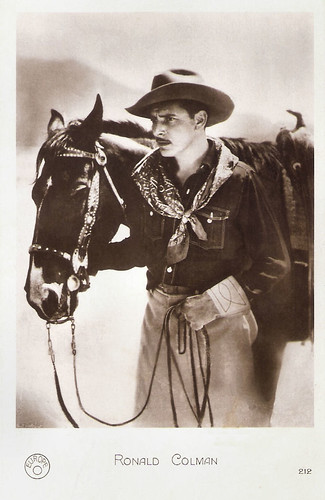
French postcard by Europe, no. 212. Photo: publicity still for The Winning of Barbara Worth (Henry King, 1926).

German postcard by Ross Verlag, no. 1795/3, 1927-1928. Photo: United Artists. Ronald Colman and Vilma Bánky in The Winning of Barbara Worth (Henry King, 1926).

German postcard by Ross Verlag, no. 2079/2, 1927-1928. Photo: United Artists. Ronald Colman in The Magic Flame (Henry King, 1927).
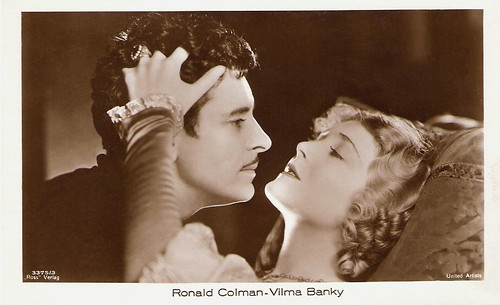
German postcard by Ross Verlag, no. 3375/3, 1928-1929. Photo: United Artists. Publicity still for Two Lovers (Fred Niblo, 1928) with Vilma Bánky.

German postcard by Ross Verlag, no. 3377/1, 1928-1929. Photo: United Artists.

German postcard by Ross Verlag, no. 3377/4, 1928-1929. Photo: United Artists. Ronald Colman in Two Lovers (Fred Niblo 1928).
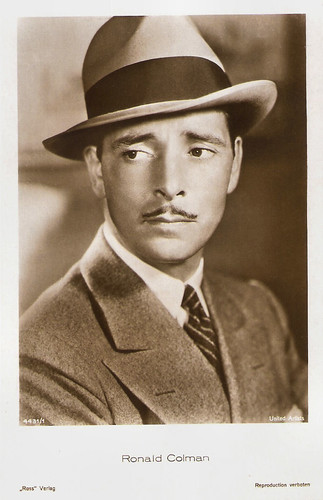
German postcard by Ross Verlag, no. 4431/1, 1929-1930. Photo: United Artists.
Romantic tearjerker
In 1920 Ronald Colman set out for New York in hopes of finding greater fortune there than in war-depressed England. His American film debut was in the tawdry melodrama Handcuffs or Kisses? (George Archainbaud, 1920). He toured with Robert Warwick in 'The Dauntless Three', and subsequently toured with Fay Bainter in 'East is West'.
After two years of impoverishment, he was cast in the Broadway hit play 'La Tendresse' (1922). Director Henry King spotted him and cast him as Lillian Gish's leading man in The White Sister (Henry King, 1923), filmed in Italy. The romantic tear-jerker was wildly popular and Colman was quickly proclaimed a new film star.
This success led to a contract with prominent independent film producer Samuel Goldwyn, and in the following ten years, he became a very popular silent film star in both romantic and adventure films. Among his most successful films for Goldwyn were The Dark Angel (George Fitzmaurice, 1925) with Hungarian actress Vilma Bánky, Stella Dallas (Henry King, 1926), the Oscar Wilde adaptation Lady Windermere's Fan (Ernst Lubitsch, 1925) and The Winning of Barbara Worth (Henry King, 1926) with Gary Cooper.
Colman's dark hair and eyes and his athletic and riding ability led reviewers to describe him as a ‘Valentino type’. He was often cast in similar, exotic roles. The film that cemented this position as a top star was Beau Geste (Herbert Brenon, 1926), Paramount's biggest hit of 1926. It was the rousing tale of three brothers (Colman, Neil Hamilton and Ralph Forbes), who join the Foreign Legion to escape the law. Beau Geste was full of mystery, desert action, intrigue and above all, brotherly loyalty. Colman's gentlemanly courage and quiet strength were showcased to perfection in the role of the oldest brother, Beau. The film is still referred to as possibly the greatest Foreign Legion film ever produced.
Towards the end of the silent era, Colman was teamed again with Vilma Bánky under Samuel Goldwyn. The two would make a total of five films together and their popularity rivalled that of Greta Garbo and John Gilbert.

German postcard by Ross Verlag, no. 4431/2, 1929-1930. Photo: Kenneth Alexander / United Artists.

French postcard by Cinémagazine-Edition, Paris, no. 495. Photo: United Artists. Ronald Colman and Vilma Bánky in The Magic Flame (Henry King, 1927).
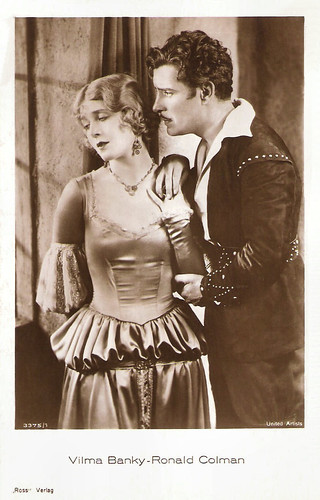
German postcard by Ross Verlag, no. 3375/1, 1928-1929. Photo: United Artists. Publicity still for Two Lovers (Fred Niblo, 1928) with Vilma Bánky.

German postcard by Ross Verlag, no. 3667/1, 1928-1929. Photo: United Artists. Publicity still for The Rescue (Herbert Brenon, 1929).

German postcard by Ross Verlag, no. 4029/1, 1929-1930. Photo: United Artists. Ronald Colman and Lily Damita in The Rescue (Herbert Brenon, 1929).

German postcard by Ross Verlag, no. 4780/1, 1929-1930. Photo: United Artists. Ronald Colman and Joan Bennett in Bulldog Drummond (F. Richard Jones, 1929).
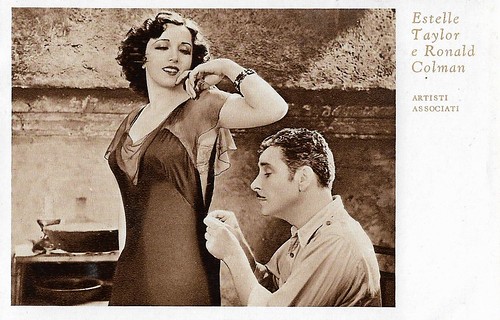
Italian postcard by Cinema-Illustrazione, series 2, no. 24. Photo: United Artists. Estelle Taylor and Ronald Colman in The Unholy Garden (George Fitzmaurice, 1931).
Sophisticated thoughtful characters of integrity
Although Ronald Colman was a huge success in silent films, with the coming of sound, his extraordinarily beautiful speaking voice made him even more important to the film industry. His first major talkie success was in 1930 when he was nominated for the Academy Award for Best Actor for two roles - Condemned (Wesley Ruggles, 1929) with Lily Damita, and Bulldog Drummond (F. Richard Jones, 1929) with Joan Bennett.
Thereafter he played several sophisticated, noble characters with enormous aplomb such as Clive of India (Richard Boleslawski, 1935) with Colin Clive, but he also swashbuckled expertly when called to do so in films like The Prisoner of Zenda (John Cromwell, 1937) with Madeleine Carroll.
A falling out with Goldwyn in 1934 prompted Colman to avoid long-term contracts for the rest of his career. He became one of just a handful of top stars to successfully freelance, picking and choosing his assignments and studios. His notable films included the Charles Dickens adaptation A Tale of Two Cities (Jack Conway, 1935), the poetic classic Lost Horizon (Frank Capra, 1937), and If I Were King (Frank Lloyd, 1938) with Basil Rathbone as vagabond poet Francois Villon.
During the war, he made two of his very best films - Talk of the Town (George Stevens, 1942) with Cary Grant and Jean Arthur, and the romantic tearjerker Random Harvest (Mervyn LeRoy, 1942), as an amnesiac victim, co-starring with the luminous Greer Garson. For his role in A Double Life (George Cukor, 1947), an actor playing Othello who comes to identify with the character, he won both the Golden Globe for Best Actor in 1947 and the Best Actor Oscar in 1948. Colman made many guest appearances on The Jack Benny Program on the radio, alongside his second wife, British stage and screen actress Benita Hume. Their comedy work as Benny's next-door neighbours led to their own radio comedy The Halls of Ivy from 1950 to 1952, and then on television from 1954 to 1955.
Incidentally, he appeared in films, such as the romantic comedy Champagne for Caesar (Richard Whorf, 1950), and his final film The Story of Mankind (Irwin Allen, 1957) with Hedy Lamarr. Hal Erickson at AllMovie: "a laughably wretched extravaganza from which Colman managed to emerge with his dignity and reputation intact." Ronald Colman died in 1958, aged 67, from a lung infection in Santa Barbara, California. He was survived by Benita Hume, and their daughter Juliet Benita Colman (1944). In 1975, Juliet published the biography 'Ronald Colman: A Very Private Person'.
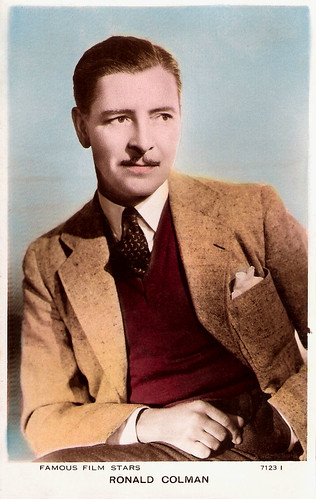
British Valentine's postcard in the Famous Film Stars Series, no. 7123 I.

British postcard in the Film Weekly series. Photo: United Artists. Ronald Colman and Kay Francis in Cynara (King Vidor, 1932), a romantic drama film about a British lawyer (Colman) who pays a heavy price for an affair. Francis plays his wife.
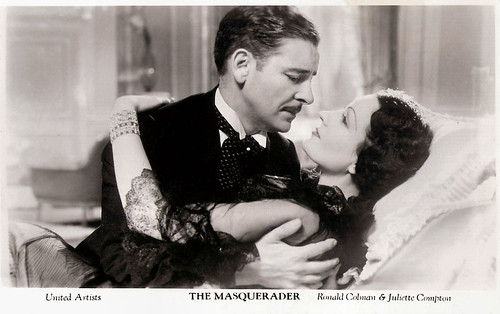
British postcard in the Filmshots series by Film Weekly. Photo: United Artists. Publicity still for The Masquerader (Richard Wallace, 1933) with Juliet Compton.

British postcard in the Film Partners Series, London, no. F 201. Photo: Metro-Goldwyn-Mayer. Ronald Colman and Elizabeth Allan in A Tale of Two Cities (Jack Conway, 1935).

Italian postcard by Vecchioni & Guadagno, Roma. Photo: Columbia EIA. Ronald Colman, Jane Wyatt and Margo in Lost Horizon (Frank Capra, 1937).

Italian postcard by Vecchioni & Guadagno, Roma. Photo: Columbia EIA. Publicity still for Lost Horizon (Frank Capra, 1937) with Jane Wyatt.

Belgian collectors card by Kwatta, Bois-D'Haine, Serie C, no. C. 170. Photo: M.G.M. Publicity still for Random Harvest (1942) with Greer Garson.
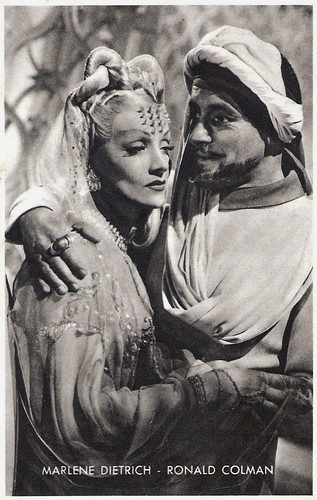
Belgian collectors card by Kwatta, Bois d'Haine, no. C 156. Photo: M.G.M. Publicity still for Kismet (William Dieterle, 1944) with Marlene Dietrich.

British postcard by De Reszke Cigarettes, no. 19 (of a series of 24 cards).

British postcard in the Picturegoer Series, London, no. W 447. Photo: Universal International.
Sources: Hal Erickson (AllMovie), Jim Beaver (IMDb), Julie Stowe (The Ronald Colman Pages), Encyclopaedia Britannica, Il Cinema Ritrova 2023, Wikipedia and IMDb.
This post was last updated on 24 February 2024.
1 comment:
Colman's Champagne For Caesar(1950) is worth a look. Amusing spoof of TV quiz shows.
Post a Comment